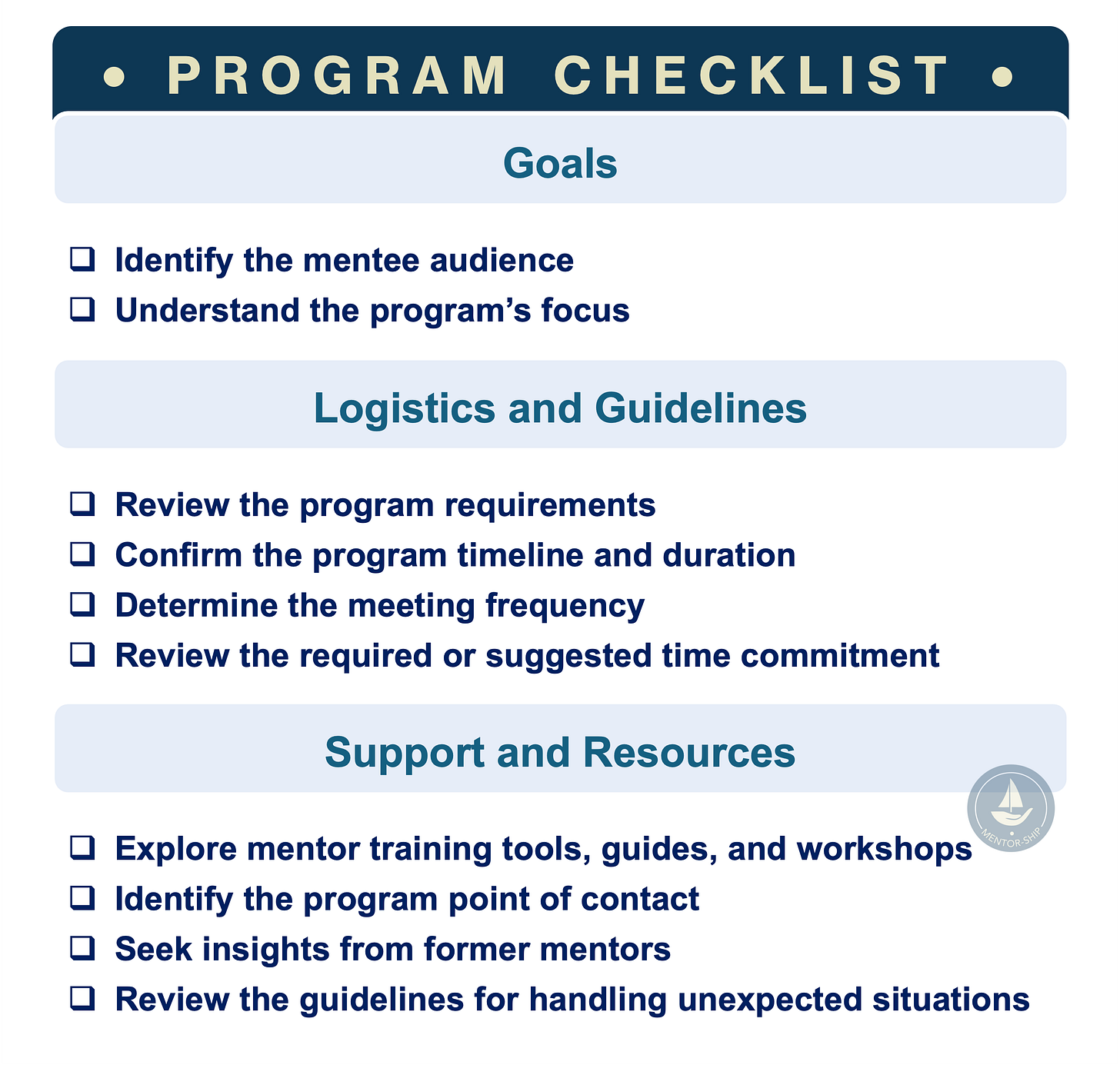⛵️Ahoy, future Captains!
In our previous Voyage Prep posts, we focused on mentees. Now it is time to turn the spotlight on you and get you ready for this adventure as a mentor.
There are many ways to become a mentor. One of the simplest is to join a mentorship program at your workplace. Other programs can be found in your community, schools and non-profit organizations. In general, these programs are often organized by a committee and supported by program managers. They are responsible for aligning the mentorship with the program goals, track metrics of success, and provide guidance for both mentors and mentees. But while program staff handle the logistics, a mentor’s success ultimately rests on their own preparation.
This post is all about one of you key responsibilities as a mentor: familiarizing yourself with the mentorship program you are signing up for. Think of it like understanding the structure of a fleet, the planned routes, the crew members, and more. One of the key secrets for a successful mentorship is gathering as much information as possible before starting a mentoring relationship.
Shall we begin?
Understanding the Program Goals
There are a few key items to consider when reviewing the goals of a mentorship program.
Identify the mentee audience. Mentorship programs often focus on specific groups. For example, underrepresented communities, women in the workplace, recent graduates, interns, or other criteria. As a mentor, it is important to be aware of the target audience and ensure your approach aligns with the program’s goals. Some mentors may specifically want to guide certain groups to gain experience and learn from it. Others may bring expertise in carving their own path to help communities navigating challenging waters. Regardless of the reason, knowing the primary mentee audience is essential.
Understanding the overall program goal. On the program call for applications, website or with the program manager, find information on what the program focuses on. It can be centered on career development, skill building, leadership, networking, degree advancement, or something else. What is important is that mentors are aligned with the program’s scope. Especially when considering longer programs (over six months), because it becomes easy to drift off course. Navigating outside the intended path can lead to confusion, misaligned expectations, and mentorship outcomes that do not reach the right destination.
💡Note: Drifting off course is different from rerouting. Sometimes mentorship goals evolve, but they typically remain within the program’s scope. For example, a PhD student in Nautical Engineering might shift focus from developing eco-friendly sails to developing sustainable, biodegradable fishing gear. The mentee is still innovating and creating a sustainable material, which keep the goal firmly within the nautical theme. Overall, the journey toward the program’s objectives should continue, guaranteeing both mentors and mentees should accomplished at the end of the journey.
The Program Logistics and Guidelines
Before joining a mentoring relationship, understanding the practical details of the program may seem secondary to the relationship itself. However, it is essential for mentors to be aware of any specific requirements the program has in place. These expectations are often mandatory or strongly recommended, because they have been based on metrics or feedback from previous participants. They exist to support a meaningful and sustainable mentorship experience for both sides.
Program requirements: Start by reviewing any specific rules, reporting requirements, or platforms the program uses. For example, some programs encourage in-person meetings, while others may require virtual sessions to happen through a specific portal. You (or your mentee) might also need to submit brief reports, complete periodic check-ins, or track your meeting online. Familiarizing with these requirements early on helps prevent surprises and allows the mentor to plan and coordinate tasks ahead of time. Otherwise, there is a high risk of either over- or under-committing, which can create unnecessary stress for both mentor and mentee.
Timeline and duration: Most formal mentorship programs define a typical duration, which can range from a few months to a full year. Knowing this timeframe helps both mentor and mentees set realistic goals. If the program allows flexibility, it is up to the captain and the skipper to agree on the length for their adventure. However, you must revisit this decision periodically with your mentee to decide whether to continue or conclude the mentorship.
Meeting and Progress: Many programs suggest a meeting frequency (e.g., once a month). This consistency builds trust and momentum. It helps with coordinating efforts, setting clear goals, providing structure and ensuring that the mentorship moves forward, with a purpose, and toward the right destination.
Time commitment: Programs often recommend a minimum time investment, but mentors should take an honest look at their own availability. It is not the number of hours that determines success, but the quality of the time spent together (remember the active listening tips from the soft skills post? If not, here is the link). Often, just 1-2 hours per month can make a meaningful difference. What matters most is consistency and presence. As a mentor, you should be very clear about your availability and flexibility up front. This helps you and the mentee to have a better match and to set boundaries that you both feel comfortable with.
How to find support and resources?
Even the most experienced mentors benefit from support. Understanding what resources are available to you can make the mentoring experience more effective and enjoyable. Every program is different, so taking the time at the beginning to learn what is in place will help you navigate the journey with more tools and confidence.
Training materials: Many programs have onboarding sessions, workshops, or written guides to help mentors prepare. These materials can be an opportunity to dive into the program goals, expectations, and best practices. Besides, program resources often draw from the experience of past participants or specialists who have experience with the program’s focus. Even if you are an experienced mentor, you should not skip these opportunities. They are often updated and tailored to the specific program, with the goal of making the mentoring experience smoother and more impactful.
Point of Contact: Before jumping into this adventure, map safe harbors. Identify who your main program contact is (the “harbor master”). This might be a program coordinator, administrator, or team lead. Knowing who to reach out when questions or concerns arise can make a big difference in the mentoring relationship. Establishing this connection early helps to acclimate into the program and fosters open communication throughout the journey.
Learning From Previous Mentors: Many programs maintain alumni groups or a list of former mentors. If you have concerns or questions, ask to speak or meet with someone who has sailed these waters before. Previous mentors can offer honest, practical advice about what worked well, common challenges, and how to make the most out of the program’s structure. These informal conversations often reveal experiences not commonly shared in official handbooks or the program’s website.

A simple, easy-to-follow checklist for mentors to review key program details before getting started. (Source: Image created by the author)
When the Mentorship Does not Go as Planned
Even with the best preparation, sometimes mentoring pairs are not the right match or circumstances shift. Just like the changing tides, there may be moments when you need to repair the boat or find a new harbor altogether.
Before starting as a mentor, ask your program’s point of contact about the process for handling situations that are unexpected. For example, what happens if you realize you are not the best fit for your mentee, or if your mentee feels the program no longer meets their needs? Ask if this has happened in the past and how the program handled the situation. Understanding these procedures in advance gives both mentor and mentee the tools to adjust gracefully, without unnecessary stress or guilt.
Sometimes, this clarity can even lead to valuable realizations: perhaps the adventure is not what one of you expected, or the mentee’s goals have shifted to a different destination. In these cases, program staff can often offer alternatives, whether that is rematching, adjusting expectations, or exploring new opportunities outside the program’s structure.
Ultimately, it is about making the most of unexpected currents and learning to fail forward: using challenges as stepping stones rather than roadblocks. (This is a theme we will explore more deeply in a future post).
🌅Another sunset is on the horizon. In this post, you learned how to find important program information about the program, and you have your checklist to make this initial step easier. As a mentor, you are getting organized to guide this adventure safely towards its destination. Along the way, you may discover that you, too, are learning and growing. That is the beauty of leaving the comforts of the harbor to sail through new currents.
In the next post, we will prepare you to identify who you are as a mentor!
Meet you at the harbor!
💬 Which program has helped you become a better mentor? Share in the comments.
⛵️Keep sailing with us! Subscribe so you don’t miss our next post…
🌊Feeling lost at sea? We’ve got your back. Message me using the link below or through my website


